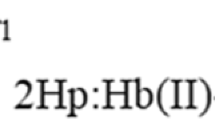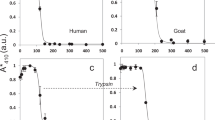Abstract
HÆMOGLOBINS from the turtle, Chelydra serpentina, the frog, Rana catesbeiana, and certain strains of mice have been shown to polymerize in vitro1. Polymerization to an octamer began after hæmolysis and was completely inhibited by either N-ethylmaleimide or iodoacetamide. Experiments to be described here indicate that oxidized and polymerized hæmoglobin appears to be a frequent constituent in high concentrations in the red cells of some species of turtles. This polymerization and oxidation of hæmoglobin can be reversed by incubation of the cells with plasma, and appears to involve the formation of double molecules linked by one or more disulphide bridges. Disulphide bonds are suggested both by the finding that very low concentrations of mercaptoethanol dissociate already formed polymer and by the inhibition of polymerization by −SH reagents.
This is a preview of subscription content, access via your institution
Access options
Subscribe to this journal
Receive 51 print issues and online access
$199.00 per year
only $3.90 per issue
Buy this article
- Purchase on Springer Link
- Instant access to full article PDF
Prices may be subject to local taxes which are calculated during checkout
Similar content being viewed by others
References
Riggs, A., Sullivan, B., and Agee, J. R., Proc. U.S. Nat. Acad. Sci., 51, 1127 (1964). Riggs, A., Science (in the press).
Dubowski, K. M., in Hemoglobin, its Precursors and Metabolites, edit. by Sunderman, F. W., and Sunderman, jun., F. W., 49 (J. B. Lippincott Co., Philadelphia, 1960).
Beutler, E., and Baluda, M. C., Blood, 22, 323 (1963).
The Pharmacopeia of the U.S.A., Sixteenth Revision, 661 (Mack Publishing Co., Easton, Penna., 1960).
Ramsay, W. N. M., Biochem. J., 38, 470 (1944). Roughton, F. J. W., Darling, R. C., and Root, W. S., Amer. J. Physiol., 142, 708 (1944). Van Slyke, D. D., Hiller, A., Weissiger, J. R., and Cruz, W. O., J. Biol. Chem., 166, 121 (1946).
Ramsay, W. N. M., in Haemoglobin, edit. by Roughton, F. J. W., and Kendrew, J. C., 231 (Interscience Publishers, Inc., New York, 1949).
Bodansky, M., Pharmacol. Rev., 3, 144 (1961).
Altland, P. D., and Brace, D. C., Amer. J. Physiol., 203, 1188 (1962).
Altland, P. D., and Thompson, E. C., Proc. Soc. Exp. Biol. and Med., 99, 456 (1958). Hirschfeld, W. J., and Gordon, A. S., Amer. Zool., 4, 305 (1964). Sheeler, P., and Barber, A. A., Comp. Biochem. Physiol., 11, 139 (1964).
Belkin, D., Science, 139, 492 (1963). Millen, J. E., Murdaugh, jun., H. V., Bauer, C. B., and Robin, E. D., Science, 145, 591 (1964). Robin, E. D., Vester, J. W., Murdaugh, jun, H. V., and Millen, J. E., J. Cell. Comp. Physiol., 63, 287 (1964).
Author information
Authors and Affiliations
Rights and permissions
About this article
Cite this article
SULLIVAN, B., REGGS, A. Hæmoglobin : Reversal of Oxidation and Polymerization in Turtle Red Cells. Nature 204, 1098–1099 (1964). https://doi.org/10.1038/2041098a0
Published:
Issue Date:
DOI: https://doi.org/10.1038/2041098a0
This article is cited by
-
Effect of pH and chloride on nitrite-induced lethality in bluegill (Lepomis macrochirus)
Bulletin of Environmental Contamination and Toxicology (1982)
-
Hematological responses of larvalRana catesbiana to sublethal nitrite exposures
Bulletin of Environmental Contamination and Toxicology (1980)
Comments
By submitting a comment you agree to abide by our Terms and Community Guidelines. If you find something abusive or that does not comply with our terms or guidelines please flag it as inappropriate.



